Pad Thai
This post may contain affiliate links. Please read my disclosure policy.
This Pad Thai with shrimp and tofu gives you all the flavors and taste of the authentic Pad Thai, in the comfort of your own home. Who needs takeout when you can do this in less than 30 minutes!
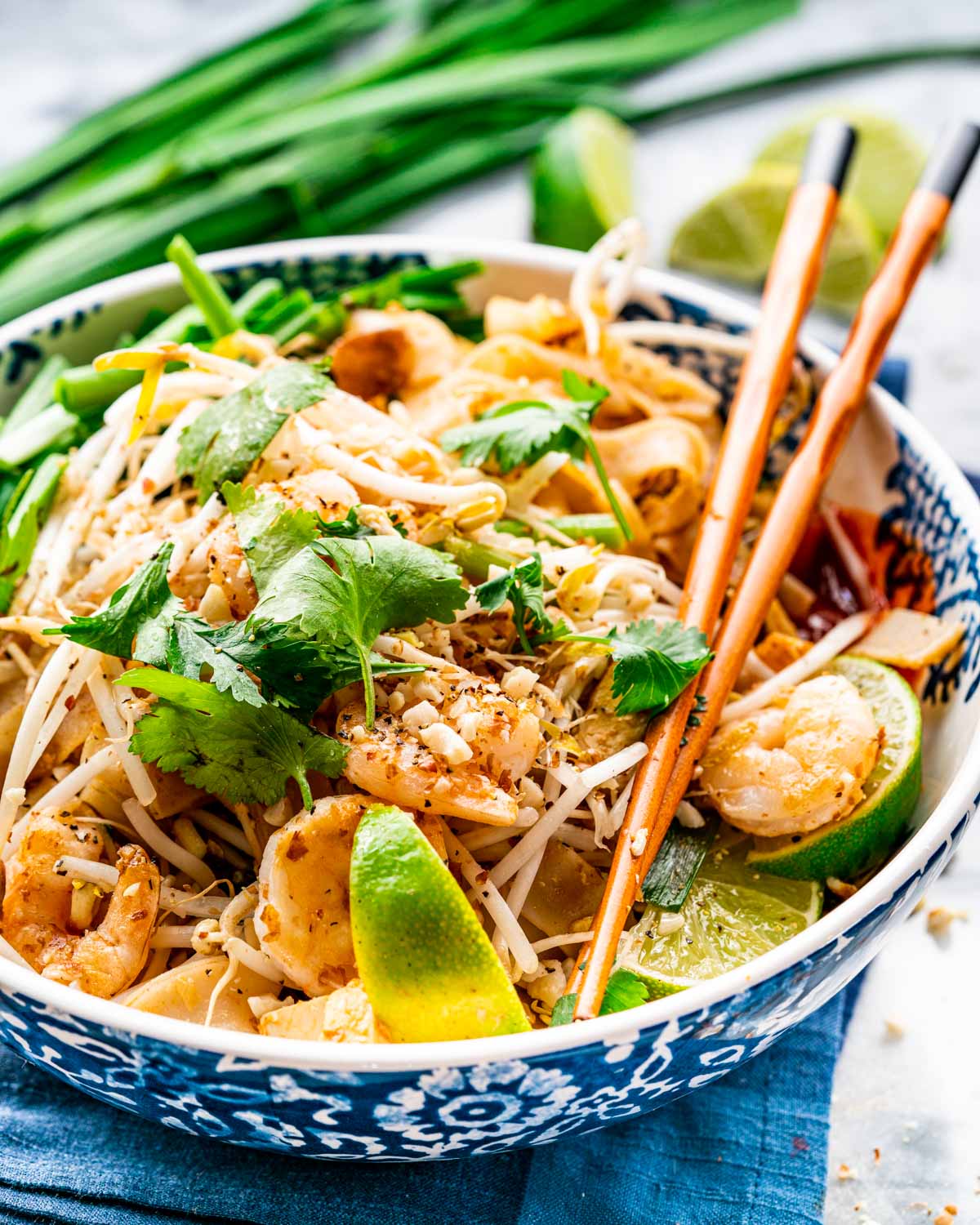
Pad Thai
Ah, Pad Thai! One of my favorite dishes, if not my favorite dish to order at a Thai restaurant. I’ve managed to find some restaurants that sell this delicious and satisfying dish, but nothing can quite compare to homemade.
My recipe is chock full of salty and satisfying dried shrimp, perfectly roasted peanuts, as well as cubed firm tofu. If you’re unfamiliar with this little flavor sponge, I’m excited to introduce you to your new favorite protein replacement! It’s all served over perfectly tender rice noodles slathered in a supremely tasty sauce.
Don’t be scared of the list of ingredients. Some may be hard to find like the dried shrimp or the Chinese chives, but I have provided substitutes for them all. However, if you have a good Asian market nearby, I really recommend going there and buying all these ingredients.
Ingredient Notes
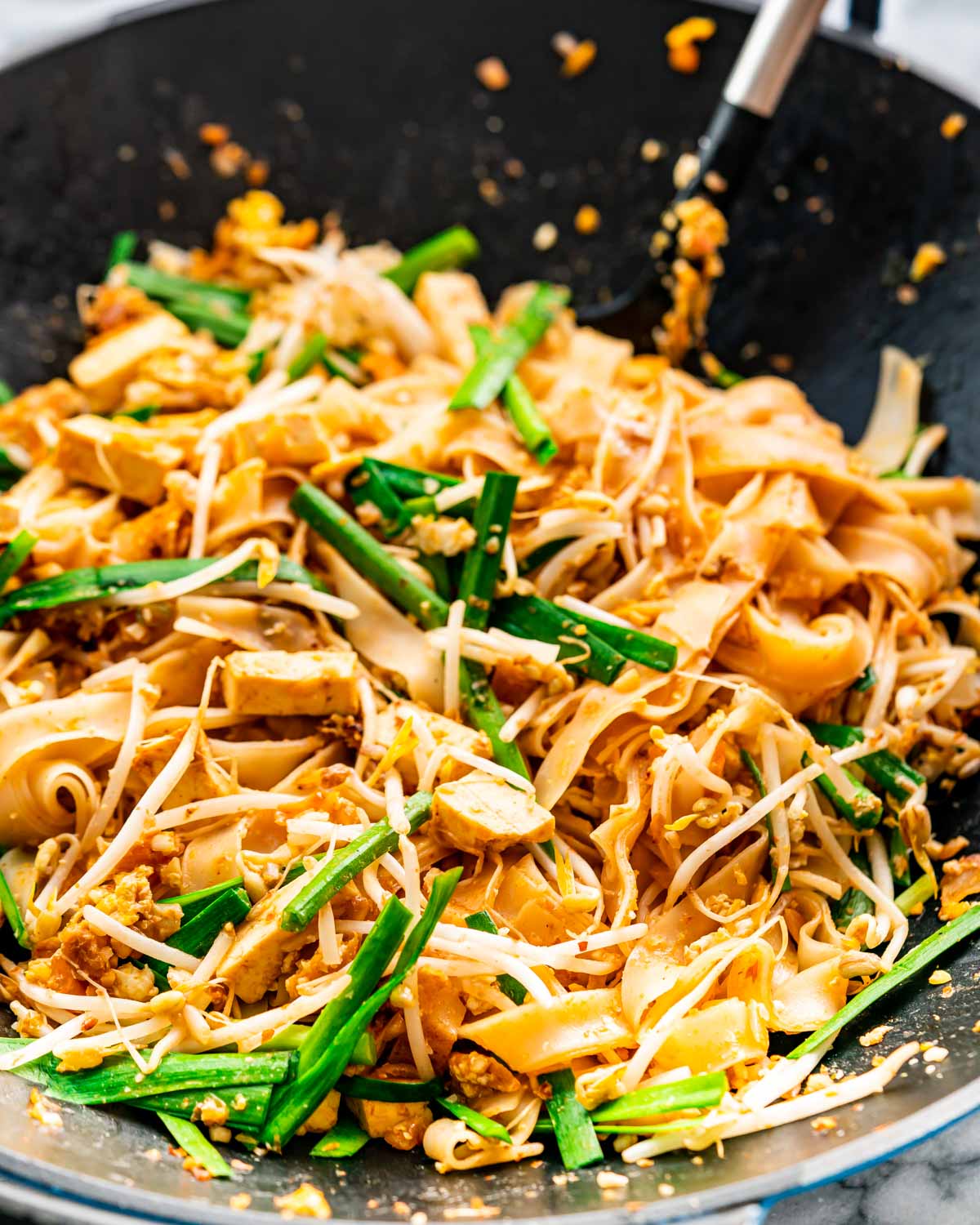
- Noodles – I’m using rice noodles today. I recommend “Thai style” rice noodles, and these can easily be found in grocery stores today.
- Aromatics – You’ll need shallots and garlic. If regular onion is all you have just use a little less as shallot has a less intense flavor.
- Shrimp – Dried shrimp and fresh plump shrimp. Dried shrimp is commonly used in Pad Thai needs to be rinsed and chopped. A great substitute is shrimp paste. Dried shrimp will give this dish a great umami and sea-food like flavor.
- Daikon – Sweet Daikon radish, available in the produce aisle. A great substitute would be white radishes which will provide a similar flavor and texture.
- Tofu – Firm tofu. You can replace this with thinly sliced pieces of chicken.
- Sriracha – To add some heat to the dish, can be omitted.
- Sprouts – I love to add fresh sprouts as a nice crunch and juicy acidity in this dish.
- Chinese chives- Chinese chives (or garlic chives) look like regular chives but much bigger and leafier. They are garlicky in flavor, juice and crisp in texture. They can be substituted with regular chives or scallions.
- Peanuts – Roasted and finely chopped. Some recipes call for peanut butter which can be used as a substitute but crushed peanuts are traditional and so much better. If you’re allergic to peanuts, simply skip this ingredient.
- Oil – Peanut oil, it’ll carry that flavor through. This can be substituted with vegetable or canola oil.
- Eggs – We’re going to create almost a scramble with these eggs in our noodles.
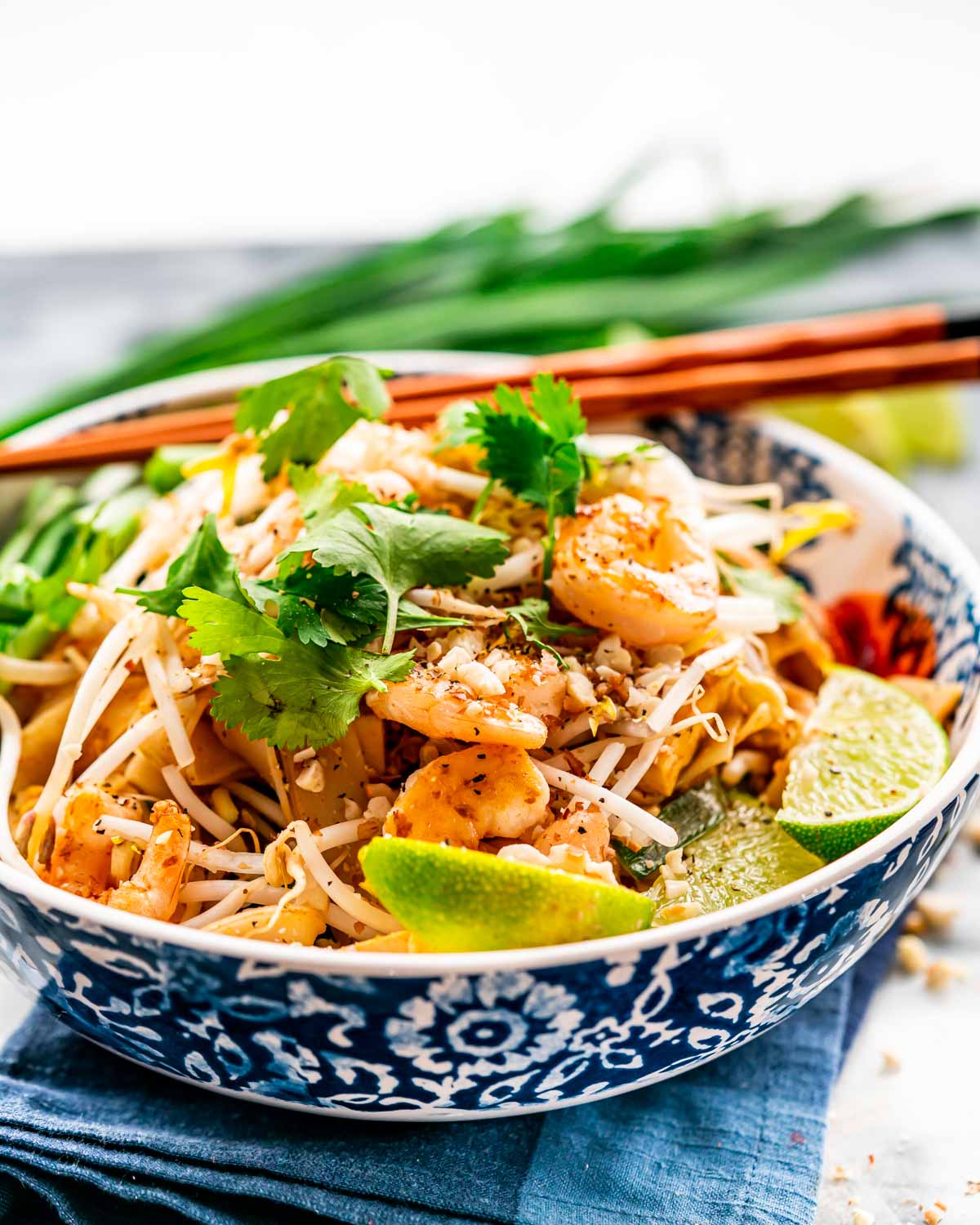
Sauce
- Brown sugar – Will help us develop a complex flavor profile for this sauce and rounds out our flavor profile.
- Tamarind paste – A common ingredient around the world, tamarind paste is both sweet and sour so I would substitute it with 1 tbsp ketchup, 2 tbsp brown sugar, 2 tbsp lime juice, 1 tbsp oyster sauce, 1 tbsp soy sauce and 1 tbsp white vinegar.
- Fish sauce – A common ingredient in lots of Asian dishes, fish sauce must be stored in the fridge after buying. It’s pretty commonly found in most grocery stores. This can be substituted with a light soy sauce.
- Water – To adjust the consistency of our sauce.
Toppings
We’re going to top this dish with even more bean sprouts, Chinese chives, and the chopped roasted peanuts. We will also want to include some of these:
- Cilantro – Fresh and chopped up well.
- Lime – Cut into wedges and squeezed over the finished dish.
- Sriracha – Even more hot sauce if you like a fiery dish!
How To Make Pad Thai
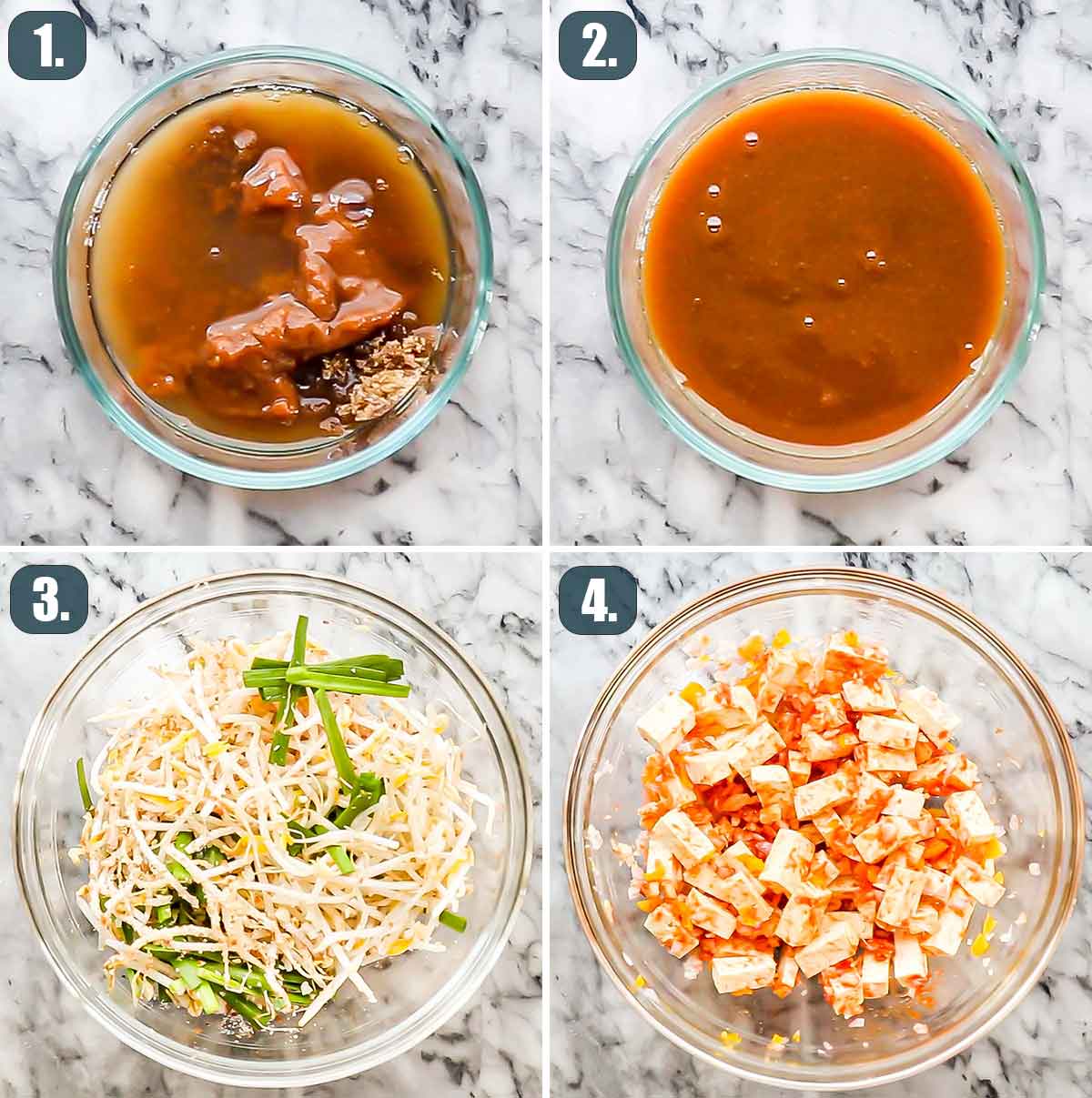
Prep All The Ingredients
- Prepare the rice noodles: Place noodles in a large bowl. Add enough cold water to cover them and let them rest for 1 hour or until noodles are pliable but not soft. Drain well in a colander. They will change color from translucent to white.
- Assemble the ingredients: In a small bowl whisk all the sauce ingredients together and set aside. In a bowl combine the shallots, garlic, dried shrimp, radishes, tofu and Sriracha. In another bowl combine the bean sprouts, chives, and ¼ cup of the peanuts.
Cook the dish
- Cook the shrimp: In a medium skillet heat 1 tbsp of peanut oil over high heat. Add the shrimp and cook and stir about 1 to 2 minutes or until shrimp turns pink and starts to slightly char. Transfer to a bowl. Add the rest of the oil to the skillet or wok.
- Build the base: Add the tofu mixture to the skillet and saute for about minute. Add the noodles and sauce to the wok and toss everything. There is water in the sauce so the noodles will cook and absorb the liquid.
- Scramble the eggs: Move the noodles to the side of the wok and add the egg and break the yolks. Add a bit more oil if necessary before adding the eggs. Let them cook for 30 seconds then scramble them. Toss everything together.
- Finish the Pad Thai: Add the bean sprouts and chives mixture to the skillet and toss everything. Turn off the heat.
Serving Pad Thai
- Serving Pad Thai properly: To serve divide noodles mixture among 2 or 4 plates, depending on the size of the meal you want. Top with shrimp then sprinkle each serving with bean sprouts, extra chives, peanuts and lime wedges. Serve with fresh cilantro and Sriracha on the side.

Frequently Asked Questions
What Is Pad Thai?
Pad Thai just means stir fry, so it’s essentially just a Thai stir fry. This means it’s a fabulous blank canvas for us to develop tons of flavor. In Thailand this dish is considered street fare and as Thailand’s street food is world renowned, this popular dish is a stand out for a reason.
What is Mise En Place?
The whole idea to making this dish is mise en place. I’ve explained mise en place before, and it basically means getting all your ingredients ready first, including chopping your vegetables, chopping the nuts, making your sauce, etc. If you do all this first, then the dish is a piece of cake, because basically all you have to do is cook the ingredients, which takes no time at all.
How Do You Use A Wok?
These dishes are usually cooked in a wok over really high heat which is why they cook so fast. Every time you add something, you basically just cook it for 30 seconds, add the next ingredients, another 30 seconds, more tossing and that’s about all there is to it. Which is why preparing your ingredients first makes all the difference. Once you start cooking you do not have time to go and chop this or that so be sure to follow my mise en place instructions above to get the most out of this dish. Although I used a wok for this recipe, a large skillet will work just as well.
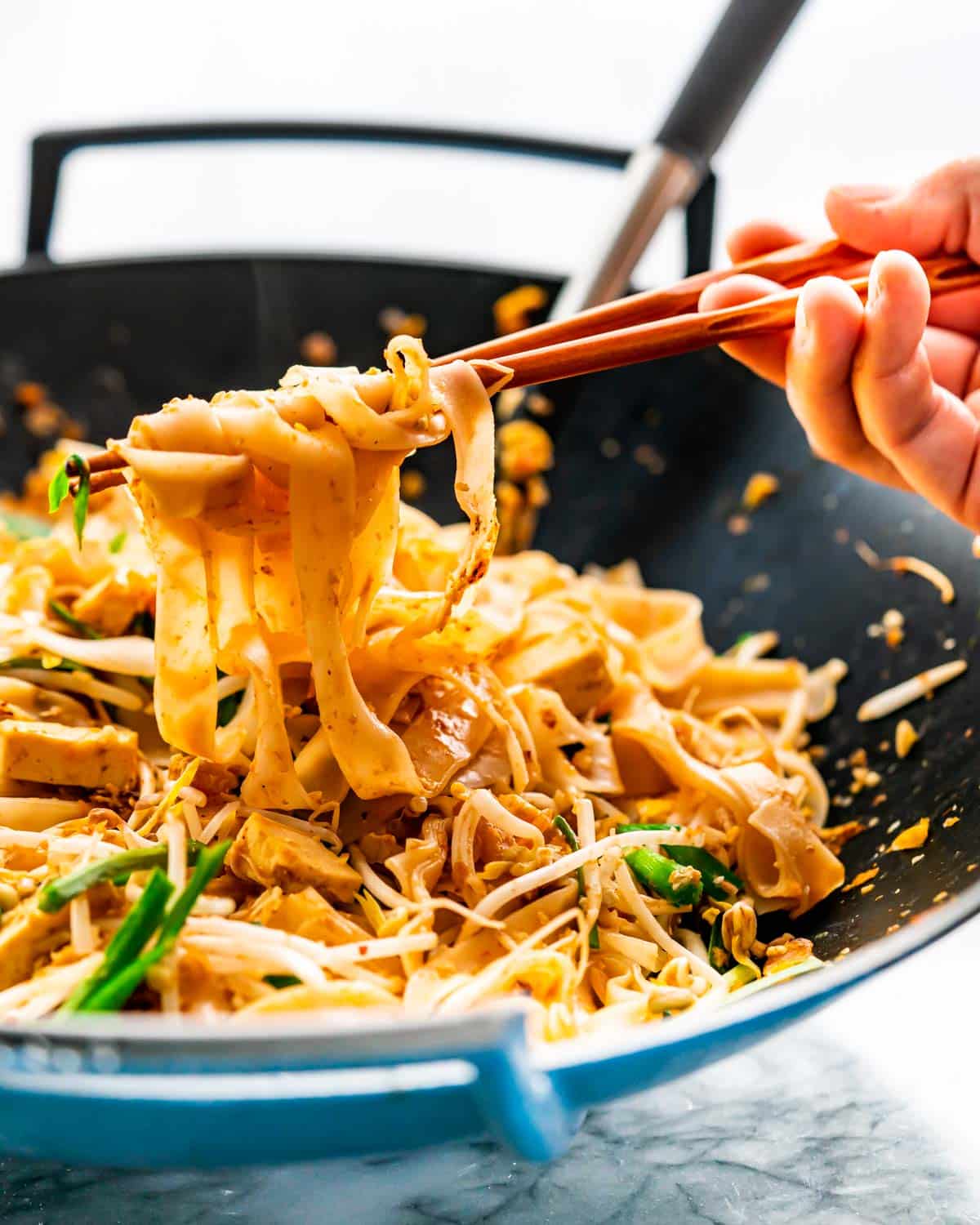
Tips
- It’s important to read the recipe once or twice before giving this recipe a go. As mentioned above, prepping all your ingredients first is the key to making a successful Pad Thai.
- Use a wok for best results. However a skillet will work as well.
- Feel free to switch up proteins. While I used shrimp and tofu, you can use chicken, beef, or even pork. The only thing I recommend is to cut them up in thin slices, for fast cooking.
Leftovers
This Pad Thai will keep for 3 – 4 days in the fridge if stored in an airtight container. I wouldn’t recommend freezing this dish as the egg and rice noodles don’t thaw well after time in the freezer.
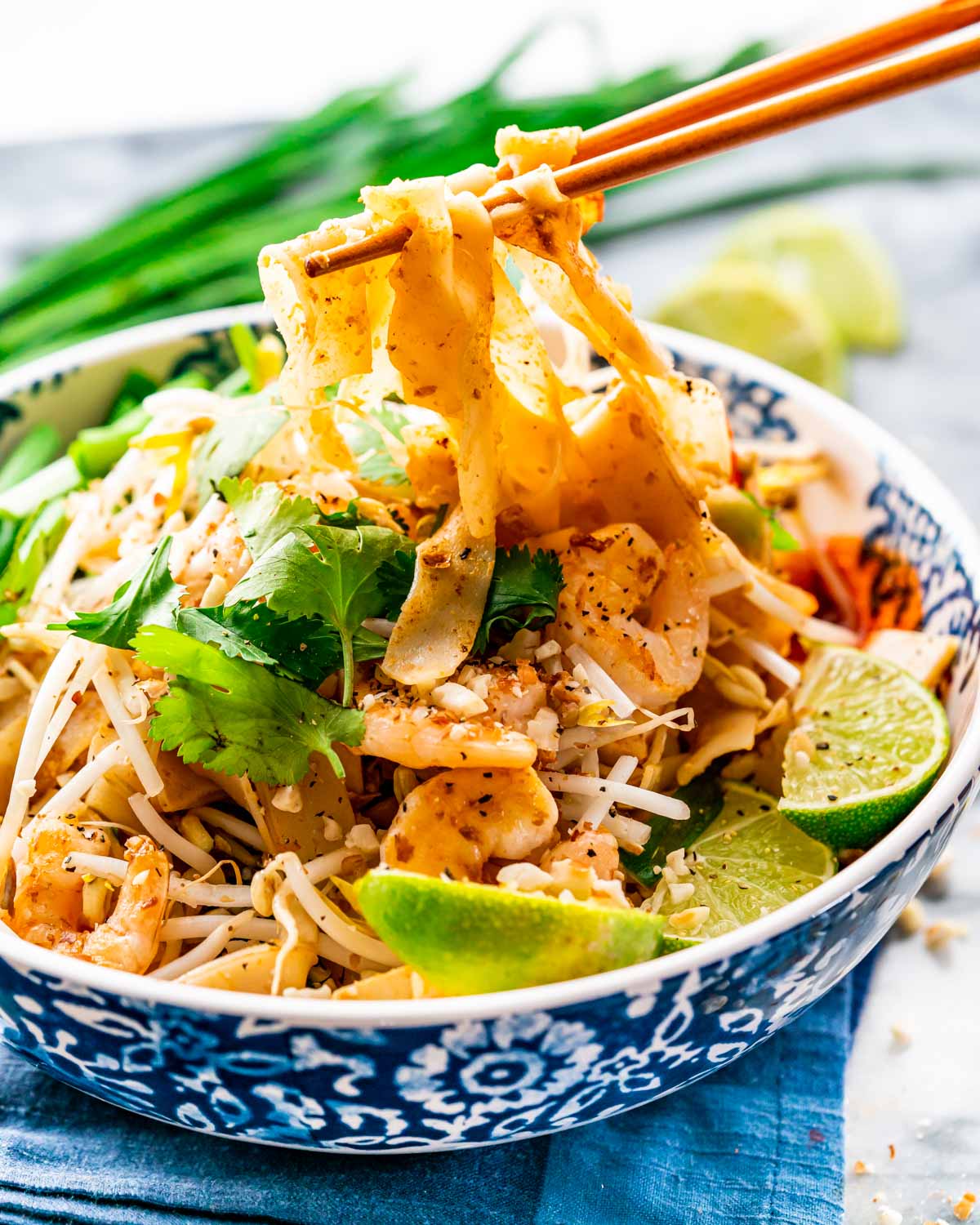
More Delicious Recipes To Try
Before You Begin! If you make this, please leave a review and rating letting us know how you liked this recipe! This helps our business thrive & continue providing free recipes.
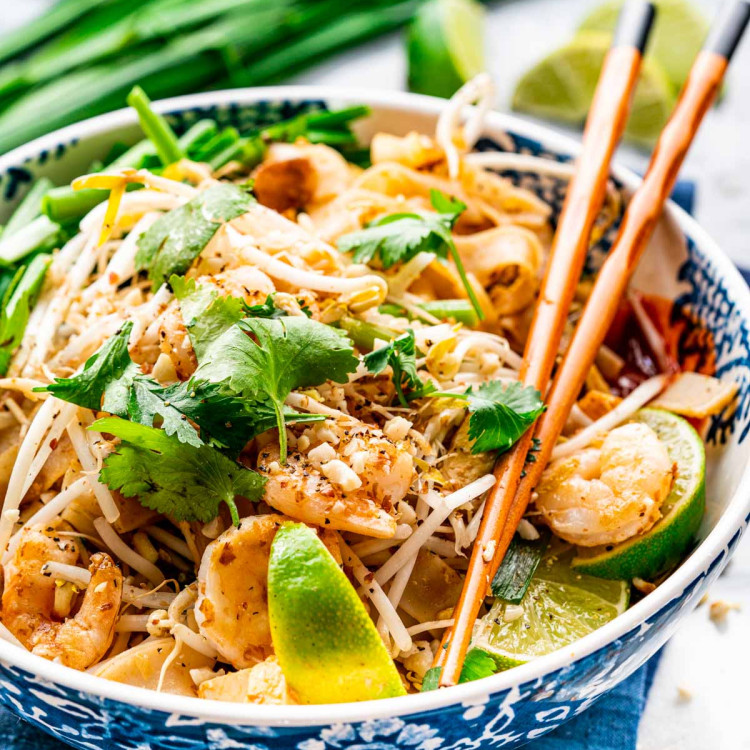
Pad Thai
Video
Ingredients
For Sauce
- 2 tablespoon brown sugar
- ¼ cup tamarind paste
- 2 tablespoon fish sauce
- 3 tablespoon water
Pad Thai
- 6 ounce rice noodles
- 2 medium shallots (minced)
- 3 cloves garlic (minced)
- 2 tablespoon dried shrimp (rinsed and chopped)
- 2 tablespoon sweet Daikon radishes (chopped)
- 8 ounce firm tofu (cut into small pieces)
- 1 tablespoon Sriracha sauce
- 1 cup fresh bean sprouts
- 1 cup Chinese chives ((or garlic chives))
- ¼ cup roasted peanuts (finely chopped)
- 2 to 3 tablespoon peanut oil
- 1 pound shrimp (shells removed and deveined if needed)
- 2 eggs
Additional Toppings
- 1 cup fresh bean sprouts
- 1 cup Chinese chives
- ¼ cup roasted peanuts (chopped)
- lime wedges
- 2 tablespoon fresh cilantro ((optional))
- Sriracha sauce
Before You Begin! If you make this, please leave a review and rating letting us know how you liked this recipe! This helps our business thrive & continue providing free recipes.
Instructions
- Prepare the rice noodles: Place noodles in a large bowl. Add enough cold water to cover them and let them rest for 1 hour or until noodles are pliable but not soft. Drain well in a colander. They will change color from translucent to white.
- Assemble the ingredients: In a small bowl whisk all the sauce ingredients together and set aside. In a bowl combine the shallots, garlic, dried shrimp, radishes, tofu and Sriracha. In another bowl combine the bean sprouts, chives, and ¼ cup of the peanuts.
- Cook the shrimp: In a medium skillet heat 1 tbsp of peanut oil over high heat. Add the shrimp and cook and stir about 1 to 2 minutes or until shrimp turns pink and starts to slightly char. Transfer to a bowl. Add the rest of the oil to the skillet or wok.
- Build the base: Add the rest of the oil to the skillet or wok. Add the tofu mixture to the skillet and saute for about minute. Add the noodles and sauce to the wok and toss everything. There is water in the sauce so the noodles will cook and absorb the liquid.
- Scramble the eggs: Move the noodles to the side of the wok and add the egg and break the yolks. Add a bit more oil if necessary before adding the eggs. Let them cook for 30 seconds then scramble them. Toss everything together.
- Finish the Pad Thai: Add the bean sprouts and chives mixture to the skillet and toss everything. Turn off the heat.
- Serving Pad Thai properly: To serve divide noodles mixture among 2 or 4 plates, depending on the size of the meal you want. Top with shrimp then sprinkle each serving with bean sprouts, extra chives, peanuts and lime wedges. Serve with fresh cilantro and Sriracha on the side.
Equipment
Notes
- Tamarind paste is a common ingredient used throughout the world. The paste is prepared from tamarind, which is a sticky sour tasting fruit that grows on bean-like pods on tamarind trees. Tamarind paste is both sweet and sour so I would substitute it with equal amounts of lime juice and brown sugar.
- Chinese chives (or garlic chives) look like regular chives but much bigger and leafier. They could be considered more vegetable rather than garnish. They are garlicky in flavor, juice and crisp in texture. Look for these chives in Asian markets. They can be substituted with regular chives or scallions.
- Dried shrimp are shrimp that have been sun-dried and shrunk to a small size. They are used in a lot of Asian dishes and give a unique umami taste. They can be found in Asian markets. Shrimp pastes can be substituted for dried shrimp.
- It’s important to read the recipe once or twice before giving this recipe a go. As mentioned above, prepping all your ingredients first is the key to making a successful Pad Thai.
- Use a wok for best results. However a skillet will work as well.
- Feel free to switch up proteins. While I used shrimp and tofu, you can use chicken, beef, or even pork. The only thing I recommend is to cut them up in thin slices, for fast cooking.
- This Pad Thai will keep for 3 – 4 days in the fridge if stored in an airtight container. I wouldn’t recommend freezing this dish as the egg and rice noodles don’t thaw well after time in the freezer.
Nutrition Information
Notice: Nutrition is auto-calculated for your convenience. Where relevant, we recommend using your own nutrition calculations.
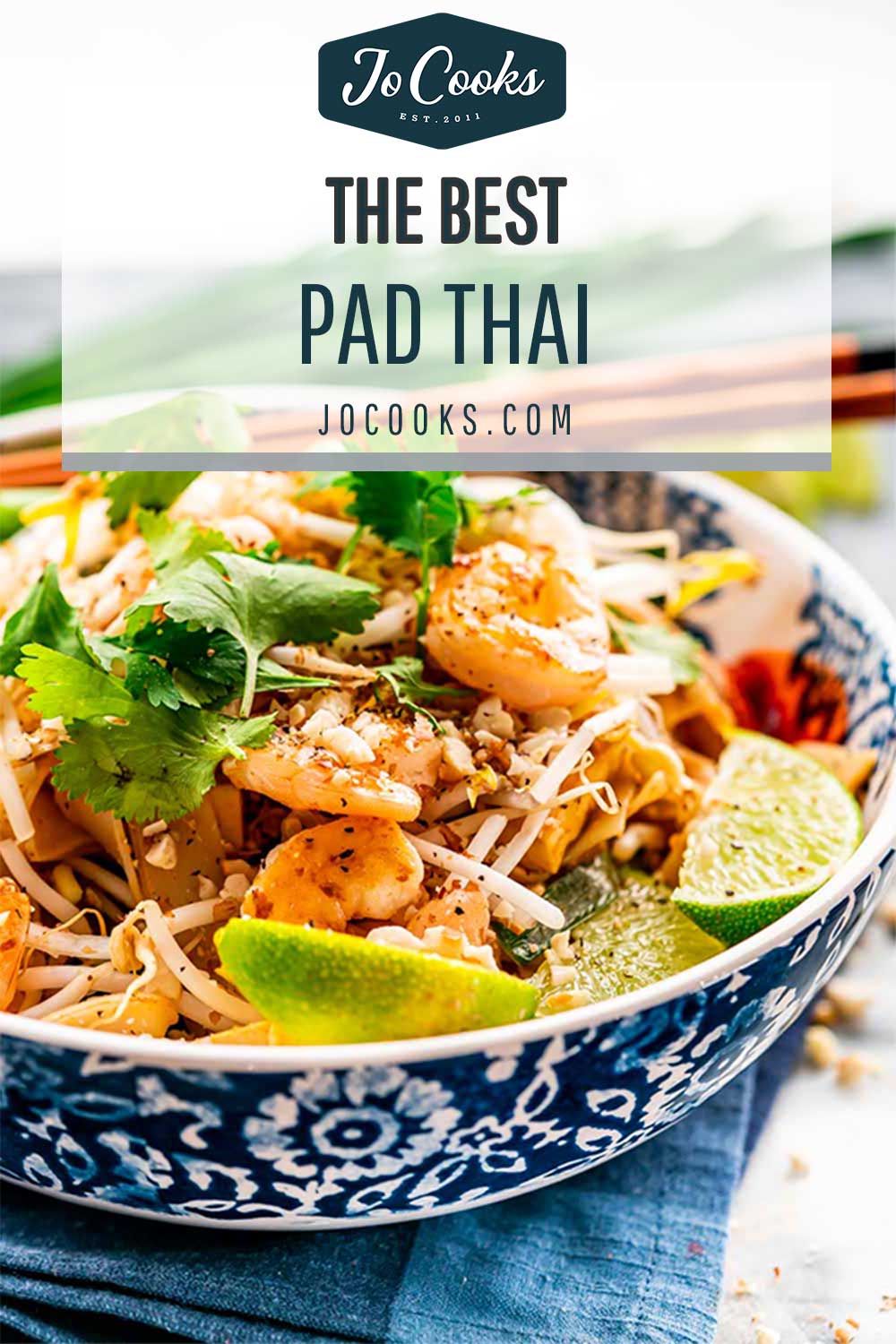
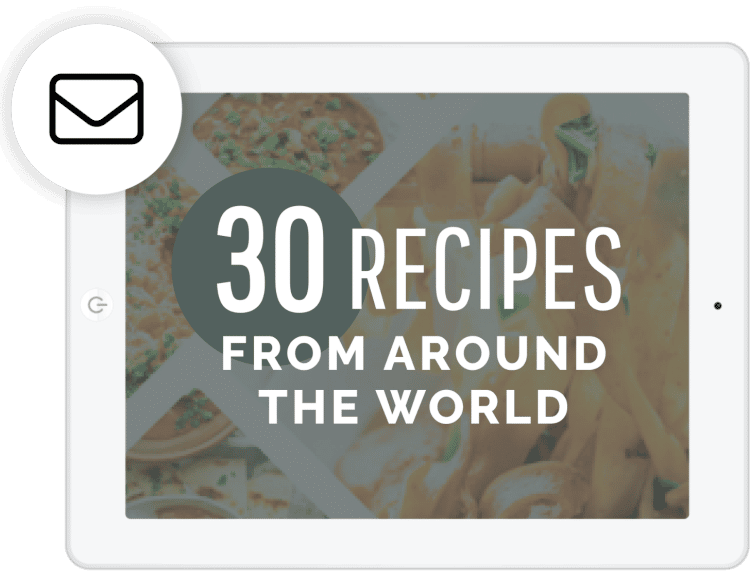
Vegetarian..what can I use for a fish sauce substitute?
You can replace it with soy sauce, Worcestershire sauce, or I believe that you can find vegan fish sauce.
So this may be the impossible…. but any stories/success with making pad Thai without peanuts?! My son is allergic, but we love all Thai food. Thanks 🙂
The peanuts are just sprinkled on top so you can simply leave them out! Use olive oil instead of peanut oil.
please tell me what are: UDON NOODLES. I can’t find them in my grocery store. May I substitute something similar?
Hi Harriet! Udon noodles are Japanese thick wheat flour noodles. You can usually find them in the Asian foods section of your grocery store. Feel free to just use regular spaghetti noodles, they will also work. 🙂
That’s soooo much sodium for one serving… ughhhh looks yummy like I was back in Phuket
My noodles didn’t turn out very well but they were brown rice noodles. I went to three stores looking for them and finally found them. They are simmering right now Im hoping for the best. Everything else seems right.
Thank you for the recipe.
You’re very welcome, I hope they turn out good.
Your picture looks beautiful! Love pad thai – look forward to trying this recipe!
I love Thai food and always try to recreate recipes of the Thai dishes. Your pad thai looks very delicious on your photo!
Thank you, I hope you try it. 🙂
Pad Thai is my favorite! I always order it at Thai restaurants, as well. I tried making it at home once and it was a big fail. I will have to try your recipe out!
Let me know how it turns out if you try it. 🙂